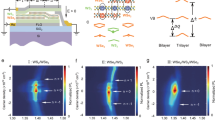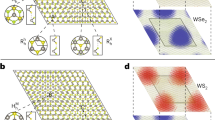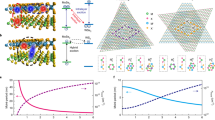Abstract
The additional layer degree of freedom in trilayer moiré superlattices of transition metal dichalcogenides enables the emergence of novel excitonic species, such as quadrupolar excitons, which exhibit unique excitonic interactions and hold promise for realizing intriguing excitonic phases and their quantum phase transitions. Concurrently, the presence of strong electronic correlations in moiré superlattices, as exemplified by the observations of Mott insulators and generalized Wigner crystals, offers a direct route to manipulate these new excitonic states and the resulting collective excitonic phases. Here we demonstrate that strong exciton–exciton and electron–exciton interactions, both stemming from robust electron correlations, can be harnessed to controllably drive transitions between quadrupolar and dipolar excitons. This is achieved by tuning either the exciton density or electrostatic doping in a trilayer semiconducting moiré superlattice. Our findings not only advance the fundamental understanding of quadrupolar excitons but also usher in new avenues for exploring and engineering many-body quantum phenomena through novel correlated excitons in semiconducting moiré systems.
This is a preview of subscription content, access via your institution
Access options
Access Nature and 54 other Nature Portfolio journals
Get Nature+, our best-value online-access subscription
$32.99 / 30 days
cancel any time
Subscribe to this journal
Receive 12 print issues and online access
$259.00 per year
only $21.58 per issue
Buy this article
- Purchase on SpringerLink
- Instant access to full article PDF
Prices may be subject to local taxes which are calculated during checkout




Similar content being viewed by others
Data availability
All data that support the plots within this paper and other findings of this study are available from the corresponding author upon reasonable request. Source data are provided with this paper.
References
Wang, G. et al. Colloquium: excitons in atomically thin transition metal dichalcogenides. Rev. Mod. Phys. 90, 021001 (2018).
He, K. et al. Tightly bound excitons in monolayer WSe2. Phys. Rev. Lett. 113, 026803 (2014).
Xu, X., Yao, W., Xiao, D. & Heinz, T. F. Spin and pseudospins in layered transition metal dichalcogenides. Nat. Phys. 10, 343–350 (2014).
Li, Z., Wang, T., Miao, S., Lian, Z. & Shi, S.-F. Fine structures of valley-polarized excitonic states in monolayer transitional metal dichalcogenides. Nanophotonics 9, 1811–1829 (2020).
Ye, Z. et al. Efficient generation of neutral and charged biexcitons in encapsulated WSe2 monolayers. Nat. Commun. 9, 3718 (2018).
Chen, X., Lian, Z., Meng, Y., Ma, L. & Shi, S.-F. Excitonic complexes in two-dimensional transition metal dichalcogenides. Nat. Commun. 14, 8233 (2023).
Mak, K. F. & Shan, J. Photonics and optoelectronics of 2D semiconductor transition metal dichalcogenides. Nat. Photon. 10, 216–226 (2016).
Ciarrocchi, A. et al. Polarization switching and electrical control of interlayer excitons in two-dimensional van der Waals heterostructures. Nat. Photon. 13, 131–136 (2019).
Jauregui, L. A. et al. Electrical control of interlayer exciton dynamics in atomically thin heterostructures. Science 366, 870–875 (2019).
Alexeev, E. M. et al. Resonantly hybridized excitons in moiré superlattices in van der Waals heterostructures. Nature 567, 81–86 (2019).
Jin, C. et al. Observation of moiré excitons in WSe2/WS2 heterostructure superlattices. Nature 567, 76–80 (2019).
Seyler, K. L. et al. Signatures of moiré-trapped valley excitons in MoSe2/WSe2 heterobilayers. Nature 567, 66–70 (2019).
Regan, E. C. et al. Mott and generalized Wigner crystal states in WSe2/WS2 moiré superlattices. Nature 579, 359–363 (2020).
Tang, Y. et al. Simulation of Hubbard model physics in WSe2/WS2 moiré superlattices. Nature 579, 353–358 (2020).
Xu, Y. et al. Correlated insulating states at fractional fillings of moiré superlattices. Nature 587, 214–218 (2020).
Huang, X. et al. Correlated insulating states at fractional fillings of the WS2/WSe2 moiré lattice. Nat. Phys. 17, 715–719 (2021).
Xiong, R. et al. Correlated insulator of excitons in WSe2/WS2 moiré superlattices. Science 380, 860–864 (2023).
Lian, Z. et al. Valley-polarized excitonic Mott insulator in WS2/WSe2 moiré superlattice. Nat. Phys. 20, 34–39 (2024).
Gao, B. et al. Excitonic Mott insulator in a Bose-Fermi-Hubbard system of moiré WS2/WSe2 heterobilayer. Nat. Commun. 15, 2305 (2024).
Shimazaki, Y. et al. Strongly correlated electrons and hybrid excitons in a moiré heterostructure. Nature 580, 472–477 (2020).
Wang, X. et al. Intercell moiré exciton complexes in electron lattices. Nat. Mater. 22, 599–604 (2023).
Jones, A. M. et al. Spin–layer locking effects in optical orientation of exciton spin in bilayer WSe2. Nat. Phys. 10, 130–134 (2014).
Lian, Z. et al. Exciton superposition across moiré states in a semiconducting moiré superlattice. Nat. Commun. 14, 5042 (2023).
Zhang, Y. et al. Every-other-layer dipolar excitons in a spin-valley locked superlattice. Nat. Nanotechnol. 18, 501–506 (2023).
Chen, D. et al. Tuning moiré excitons and correlated electronic states through layer degree of freedom. Nat. Commun. 13, 4810 (2022).
Yu, L. et al. Observation of quadrupolar and dipolar excitons in a semiconductor heterotrilayer. Nat. Mater. 22, 1485–1491 (2023).
Lian, Z. et al. Quadrupolar excitons and hybridized interlayer Mott insulator in a trilayer moiré superlattice. Nat. Commun. 14, 4604 (2023).
Li, W. et al. Quadrupolar–dipolar excitonic transition in a tunnel-coupled van der Waals heterotrilayer. Nat. Mater. 22, 1478–1484 (2023).
Deilmann, T. & Sommer Thygesen, K. Quadrupolar and dipolar excitons in symmetric trilayer heterostructures: insights from first principles theory. 2D Mater. 11, 035032 (2024).
Slobodkin, Y. et al. Quantum phase transitions of trilayer excitons in atomically thin heterostructures. Phys. Rev. Lett. 125, 255301 (2020).
Astrakharchik, G. E., Kurbakov, I. L., Sychev, D. V., Fedorov, A. K. & Lozovik, Y. E. Quantum phase transition of a two-dimensional quadrupolar system. Phys. Rev. B 103, L140101 (2021).
Xie, Y. et al. Bright and dark quadrupolar excitons in the WSe2/MoSe2/WSe2 heterotrilayer. Phys. Rev. Lett. 131, 186901 (2023).
Bai, Y. et al. Evidence for exciton crystals in a 2D semiconductor heterotrilayer. Nano Lett. 23, 11621–11629 (2023).
Tong, Q., Chen, M., Xiao, F., Yu, H. & Yao, W. Interferences of electrostatic moiré potentials and bichromatic superlattices of electrons and excitons in transition metal dichalcogenides. 2D Mater. 8, 025007 (2021).
Chen, D. et al. Excitonic insulator in a heterojunction moiré superlattice. Nat. Phys. 18, 1171–1176 (2022).
Acknowledgements
We thank C. Jin for helpful discussions. S.-F.S. acknowledges support from NSF (DMR-1945420, DMR-2428545, ECCS-2344658 and ECCS-2139692) and a community collaboration award from the Pittsburgh Quantum Institute. The optical spectroscopy measurements were supported by an AFOSR DURIP award through grant number FA9550-23-1-0084. Y.-T.C. acknowledges support from NSF under award numbers DMR-2104805 and DMR-2145735. K.W. and T.T. acknowledge support from JSPS KAKENHI (grant numbers 21H05233 and 23H02052) and the World Premier International Research Center Initiative (WPI), MEXT, Japan. S.A.T. acknowledges primary support from DOE-SC0020653 (materials synthesis), Applied Materials Inc., DMR 2111812, DMR 2206987 and CMMI 2129412. The work at LANL is partially supported by the US Department of Energy (DOE) National Nuclear Security Administration (NNSA) under contract number 89233218CNA000001 through the Laboratory Directed Research and Development (LDRD) Program and was performed, in part, at the Center for Integrated Nanotechnologies, an Office of Science User Facility operated for the DOE, Office of Science, under user proposal numbers 2018BU0010 and 2018BU0083.
Author information
Authors and Affiliations
Contributions
S.-F.S. conceived the project. Y.M. and D.C. fabricated the heterostructure devices. L.Y. and L.M. performed the optical spectroscopy measurements. R.B. and S.A.T. grew the TMDC crystals. T.T. and K.W. grew the boron nitride crystals. S.-Z.L. and W.Y. contributed to the theoretical understanding. A.K. and S.C. contributed to the theoretical calculations. S.-F.S., Y.M., L.M. and L.Y. analysed the data. S.-F.S. wrote the manuscript with the help of Y.-T.C., S.-Z.L., L.Y., L.M., Y.M., S.Z. and B.H., and input from all authors.
Corresponding author
Ethics declarations
Competing interests
The authors declare no competing interests.
Peer review
Peer review information
Nature Photonics thanks the anonymous reviewers for their contribution to the peer review of this work.
Additional information
Publisher’s note Springer Nature remains neutral with regard to jurisdictional claims in published maps and institutional affiliations.
Extended data
Extended Data Fig. 1 Electric field dependent PL spectra for device D2.
(a), (b), and (c) are PL spectra acquired under the CW optical excitation with the excitation intensity of 0.053 µW/µm2, 12.7 µW/µm2, and 259.1 µW/µm2, respectively. (d) Colour plot of the normalized integrated PL intensity as a function of the excitation intensity and nominal electric field. The measurements were performed at a temperature of 3.6 K.
Extended Data Fig. 2 Electric field dependent PL spectra at excitation intensities from 0.25 µW/µm2 (a) to 660.4 µW/µm2 (p).
The extracted PL peak positions are shown as white dots. All photon energy axes share the same scale as shown in the bottom row for consistent comparison of peak shifts. The measurements were performed at a temperature of 3.6 K.
Extended Data Fig. 3 Schematics of QX-to-DX transition at n = -1.
The pink and purple spheres refer to the optically excited hole and electrostatically introduced hole, respectively. (a) shows the exciton configuration as a QX for the doping of less than one hole per moiré unit cell. (b) and (c) show two competing exciton configurations when electrostatic doping at n = −1. Calculations in Supplementary Section 10 show that the configuration of (c) is of the lower energy.
Extended Data Fig. 4 Normalized integrated PL intensity as a function of the doping and nominal electric field in the n-doping regime.
The gray bar indicates the intrinsic region of the device, and a detailed discussion can be found in Supplementary Section 9. White arrows suggest the filling factor of n = 1/3, 2/3, and 1, respectively. The PL spectra were taken with the CW laser excitation intensity of 3.2 µW/µm2 and temperature of 7 K.
Supplementary information
Supplementary Information
Supplementary Sections 1–13 and Figs. 1–17.
Source data
Source Data Fig. 1
Numerical source data for Fig. 1d.
Source Data Fig. 2
Numerical source data for Fig. 2a–d.
Source Data Fig. 3
Numerical source data for Fig. 3a–f.
Source Data Fig. 4
Numerical source data for Fig. 4a.
Source Data Extended Data Fig. 1
Numerical source data for Extended Data Fig. 1a–d.
Source Data Extended Data Fig. 2
Numerical source data for Extended Data Fig. 2a–p.
Source Data Extended Data Fig. 4
Numerical source data for Extended Data Fig. 4.
Rights and permissions
Springer Nature or its licensor (e.g. a society or other partner) holds exclusive rights to this article under a publishing agreement with the author(s) or other rightsholder(s); author self-archiving of the accepted manuscript version of this article is solely governed by the terms of such publishing agreement and applicable law.
About this article
Cite this article
Meng, Y., Ma, L., Yan, L. et al. Strong-interaction-driven quadrupolar-to-dipolar exciton transitions in a trilayer moiré superlattice. Nat. Photon. (2025). https://doi.org/10.1038/s41566-025-01741-x
Received:
Accepted:
Published:
DOI: https://doi.org/10.1038/s41566-025-01741-x



